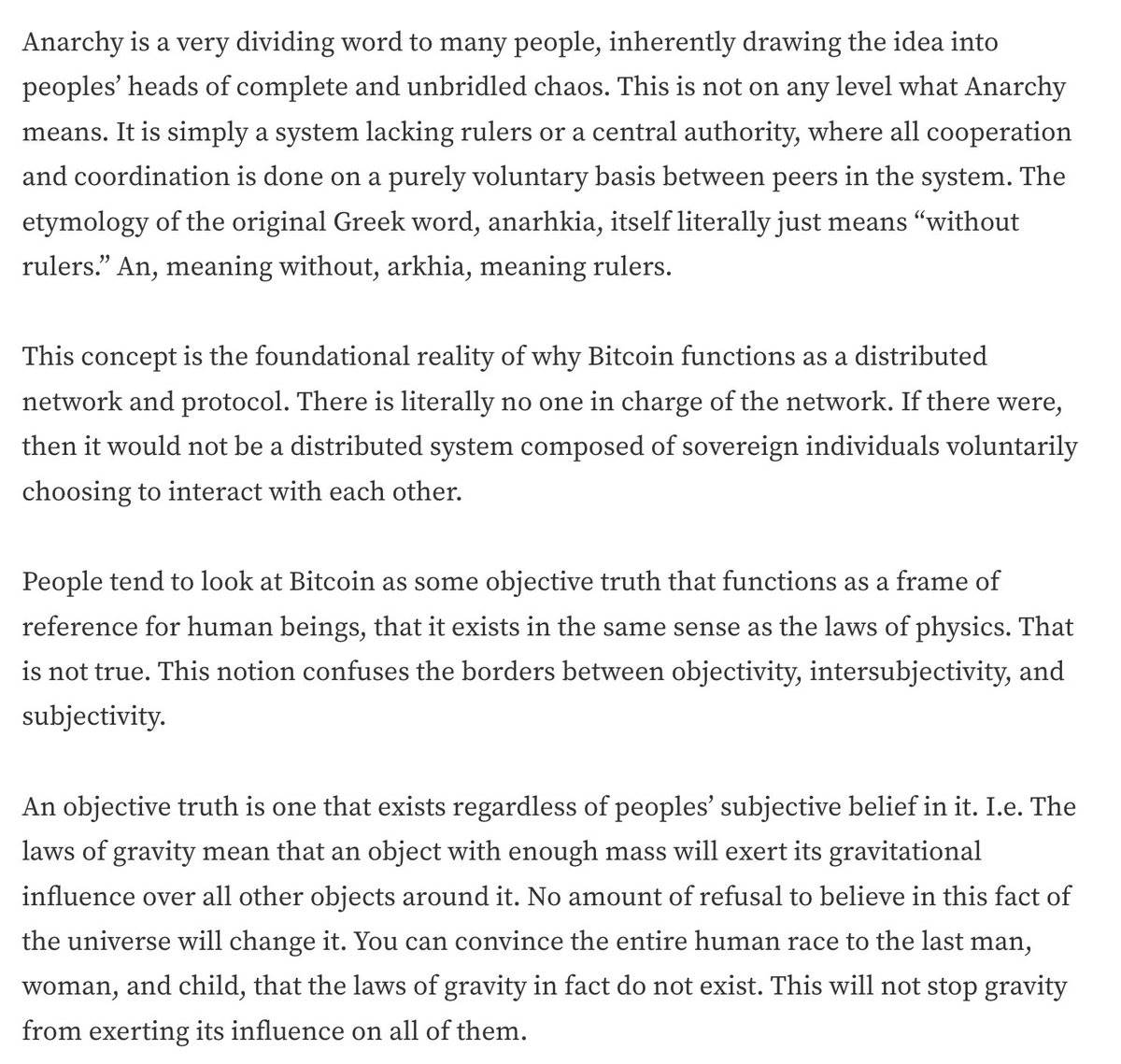In the watershed of encrypted history, where is the next bull market?

Reprinted from panewslab
02/10/2025·15DAuthor: hitesh.eth
Compiled by: TechFlow
I won't confirm or challenge your opinion through charts, historical structure comparisons, or popular theories - so if you're just looking for recognition, or expecting to see information that matches your expectations, you might be disappointed. Because what I want to talk about next requires you to focus on every detail I share.
Two ways to move forward
At present, the crypto market is at a critical crossroads, facing two different paths forward – each with its unique advantages and disadvantages.
The first road leads to more freedom and adventure, while the second road means stronger control and constraints.
The Essence of Encryption: Pursuing Anarchy
Cryptotech is not an emerging concept—its philosophy has been brewing for fifty or sixty years. Thousands of cryptologists have laid the foundation for today's technological development. Their goal is to build a true "crypto-anarchy".

This is a world where no legal identity is required, a society where everyone can be anonymous, an ecosystem that is completely free from government control. In this ecosystem, all transactions such as governance, currency, communication, interaction and collaboration are achieved in a decentralized manner through encryption technology.
In such a world, people can freely create open markets, conduct unconditional transactions, avoid taxes, and control their wealth and lives.
However, our lives have been under the control of corrupt governments and banks for a long time. By creating a false sense of security, governments have made us never realize that we have been trapped in this economic trap for hundreds of years.
Bitcoin: The Wake-up Call
We need an awakening, and Bitcoin is the call for this awakening.
Bitcoin points the way to build crypto anarchy. It provides a completely new alternative to traditional financial systems, allowing individuals to fully control their wealth without relying on banks or governments. Bitcoin has achieved a truly decentralized, censored and transparent monetary system for the first time. "The word anarchy is controversial to many, and it often reminds of total out-of-control chaos. However, in fact, it really doesn't mean that. Anarchy just refers to a kind of person without a ruler or a central authority System, in which all cooperation and coordination are based entirely on voluntary behaviors between individuals within the system. From the etymology, the Greek anarhkia literally means no ruler, where an means no, arkhia means ruler.
This concept is the core basis for Bitcoin to function normally by distributed networks and protocols. No one has absolute control in the Bitcoin network. If there is a centralized controller, then Bitcoin is no longer a distributed system composed of autonomous individuals who interact with each other based on the principle of voluntary action.
Some tend to see Bitcoin as an objective truth similar to the laws of physics, believing it can serve as a reference framework for human behavior. However, this view is not correct. It actually confuses the differences between objectivity, intersubjectivity and subjectivity.
Objective truth refers to a fact that exists regardless of whether people believe it or not. For example, the law of universal gravitation shows that an object with sufficient mass exerts gravitational influence on other objects around it. Even if all humans—every man, woman, and child—are convinced that gravity does not exist, it will not change the fact that gravity continues to act on them. ”

Image source: BitcoinMagazine
In 2008, Satoshi Nakamoto released a white paper on Bitcoin. This is not only a technological revolution, but also an ideological change. It raises doubts about centralized monetary control and reveals the inherent flaws of the fiat currency system manipulated by governments and financial elites. This marks the first step for human civilization to begin to get rid of long-term economic oppression.
The emergence of Ethereum further promotes the development of blockchain technology. It builds a complete development infrastructure that enables developers to explore various application scenarios of blockchain, thus setting off the first wave of crypto-anarchy.
Tokenize everything
To achieve crypto-anarchy, we need a powerful infrastructure that allows people to tokenize various things—whether concepts described in words or content presented in images, can be tokenized in the form of tokenization Give it new value and build a liquid market around these things.
"Computer technology is heading for a whole new era that will give individuals and groups the ability to communicate and interact in a completely anonymous way. Two people can exchange information, conduct business, and sign electronic contracts without knowing the other person's real name or Legal identity. With widely rerouted encrypted packets and almost completely tamper-proof encryption protocols, interactions on the network will become untraceable. In such an environment, reputation will become the most important asset, and its importance will exceed even greater Today’s credit ratings. The development of these technologies will revolutionize the way government regulates, affects the ability to control taxes and economically, and will also subvert the traditional way of information confidentiality and even reshape the definition of trust and reputation.
The theoretical basis of this coming revolution—which will undoubtedly be a social and economic double revolution—was established ten years ago. Its core technologies include public key encryption, Zero-Knowledge Interactive Proof Systems, and a variety of software protocols for interaction, authentication and verification. In the past, these studies have focused primarily on academic conferences in Europe and the United States and have been closely monitored by the National Security Agency. Until recently, however, computer networks and personal computers have not been fast enough to make these theories a reality. Further technological developments will make these concepts economically viable and almost impossible to stop over the next decade. Technologies such as high-speed networks, ISDNs, tamper-proof devices, smart cards, satellites, Ku-band transmitters, multi-core high-performance personal computers, and encryption chips under development will be the key to driving this change.
Of course, the state will try to stop the spread of this technology through various means, including national security, the potential use of technology by drug dealers and tax evaders, and concerns about the collapse of social order. These concerns make sense: Crypto-anarchism may make state secrets freely traded, and may also create markets for illegal and stolen goods. Even anonymous computerized markets can experience disturbing deals such as assassination and ransomware. Various criminal organizations and foreign forces may also become the main users of "CryptoNet" (encrypted network). However, these resistances do not prevent the spread of crypto-anarchism.
Just as the invention of printing weakened the dominance of medieval guilds and social power structures, cryptography will fundamentally change the way businesses and governments intervene in economic transactions. Combined with the emerging information market, crypto anarchism will create a free-trade market for anything that can be expressed in words and images. Just as seemingly simple inventions—such as barbed wire—have fenced vast pastures and farmlands, thus completely changing the concept of land and property rights in the western frontier, discoveries from an unpopular branch in the field of mathematics will also become cut-off knowledge. Tools for property rights "barbed wire".
You have nothing to lose except the barbed wire fence that binds you! ”

Source: \"Crypto-Anarchy Declaration\"
In 1988, the legendary crypto-punk Timothy C. May portrayed a future world full of freedom and privacy in his Crypto Anarchy Manifesto. He envisions a society that is beyond the control of government and centralized control of human beings through encryption technology. In his vision, encrypted communications, anonymous transactions and decentralized systems will make traditional oppressive institutions useless. His declaration is not only a technical blueprint, but also an ideological enlightenment, laying the ideological foundation for Bitcoin and the entire cryptocurrency movement. This declaration became a call for developers and thinkers, encouraging them to see cryptography as the ultimate tool for human liberation.
Bonding Curve: The key to unlocking new markets
If you put aside the price fluctuations in the market for the time being and focus only on the trends behind it, you will find that a key liquidity startup tool was unlocked last year - that is Bonding Curve.
Bonding Curve is a mathematical model that creates thousands of different liquidity markets around anything that can be described in words. For image assets, we have witnessed the explosion of NFT (non-fungible tokens) in the last crypto market cycle. Today, this emerging experiment is gradually guiding us to build more liquidity markets to meet the needs of different fields.
Use Memes as a marketplace
On the surface, creating a liquid market for things that may be meaningless may seem absurd, but in fact, the core idea of this behavior is Memes. We are creating markets because we believe that there is always someone willing to speculate around a certain Meme or concept. So we provide them with an opportunity to participate in and profit from it through on-chain transactions.
When people participate in speculation, they often develop beliefs about what they invest in based on certain theories or data. So essentially, we are building liquidity markets for various tokenized beliefs. These markets not only meet the needs of speculators, but also promote the diversification of the entire crypto ecosystem.
The Wild West of Crypto Anarchy
In crypto-anarchy, people can trade all kinds of things, including opinions, trends, stories, articles, songs, memes, research papers, reputation, gossip, comments, recipes, and even many things we haven't imagined yet Content…This is a very free and open state.
All this was foreseeable in Timothy C. May's Declaration on Encrypted Anarchy. We should have reached this stage one day, and now, with the advancement of technology and infrastructure, we have been able to support a variety of novel liquidity markets. However, the main problem at the moment is that most of these markets are being manipulated by some powerful players who are trying to get more profits through centralized ways.
An important solution to achieve fair incentive allocation in these liquidity markets is to build a reputation layer. This system allows market participants to verify the creator's reputation before trading, and creators can also verify the user's reputation before accepting the user's reputation. https://x.com/eli5_defi/status/1830538370046673067
Now we already have technologies like ZkTLS (a zero-knowledge transport layer security protocol), as well as infrastructure like @nillionnetwork. These tools provide us with the possibility of building reputation systems, enabling a more equitable incentive allocation at the application level. As these technologies mature, we will eventually solve the reputational problem in crypto anarchy.
The future: Two clear paths
The future crypto world will present two completely different development paths, and you can switch between them according to your needs and preferences.
The first path is to participate in an evolving crypto-anarchy. Here, new markets emerge one after another, attention is rapidly shifting, and wealth fluctuates in the speculative cycle. Those who can adapt quickly to change and act will have an advantage in this environment.
The second road leads to a regulated and controlled crypto economy. Here, stability, compliance and structured investment opportunities are at the heart. This path is more suitable for traditional financial institutions and large institutional investors who tend to operate in a more predictable but also more constrained environment.
We are at a critical watershed in the history of crypto. When the United States officially introduces encryption regulations, the boundaries between the two paths will become clearer.
The regulated market will focus on Web3 companies that generate real revenue and projects with abundant cash flow, which will also be the starting point of the first bull cycle under authoritative supervision.
Meanwhile, in crypto anarchy, changes in marginal markets will continue to advance at an astonishing rate. If you face 100 markets, 99 of them may experience a decline, while the remaining one may absorb liquidity from other markets and rise rapidly. In this environment, attention will become particularly valuable, and those who can be keen on trends and flexibly respond to changes will still have an advantage in this competition.
In a corner of crypto-anarchy, there is always a bull market that is quietly brewing. Whether you can discover it and seize opportunities depends entirely on your vision and action.
Cheer up! There is nothing you have to lose except those obstacles that bind you to move forward.


 jinse
jinse